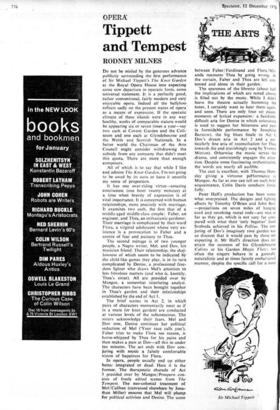OPERA
Tippett and Tempest
RODNEY MILNES
Do not be misled by the generous advance publicity surrounding the first performance of Sir Michael Tippett's The Knot Garden at the Royal Opera House into expecting some new departure in operatic form, some universal statement. It is a perfectly good, rather conventional, fairly modern and very enjoyable opera. Indeed all the ballyhoo reflects sadly on the present status of opera' as a means of expression. If the operatic climate of these islands were in any way healthy, works of comparable stature would be appearing six or seven times a year—say two each at Covent Garden and the Coll-, seum and one each at Glyndebourne and the Welsh and Scottish Nationals. In a better world the Chairman of the Arts Council might consider withdrawing the subsidy from any company that didn't meet this quota. There are more than enough composers.
All of which is to say that while I like and admire The Knot Garden, I'm not going to be awed by its aura or have it unsettle my sense of proportion.
It has one over-riding virtue—amazing conciseness (one hour twenty minutes) at a time when brevity of expression is of vital importance. It is concerned with human relationships, more precisely with marriage, It examines two such, the first that of a middle-aged middle-class couple: Faber, an engineer, and Thee, an enthusiastic gardener. Their marriage is complicated by their ward Flora, a virginal adolescent whose very ex-, istence is a provocation to Faber and a source of fear and jealousy to Thea.
The second m6nage is of two younger people, a Negro writer, Mel, and Dov, his musician friend. Their relationship, the she!, lowness of which seems to be indicated by the child-like games they play, is in its turn complicated by Denise, a professional free4 dom fighter who draws Mel's attention to less frivolous matters (and who is, knottily, Thea's sister). All are presided over by Mangus, a somewhat interfering analyst. The characters have been brought together in Thea's garden and their relationships established by the end of Act 1.
The brief scenes in Act 2, in which pairs of characters momentarily meet as if in a maze (or knot garden) are conducted at various levels of the subconscious. The sisters acknowledge their fears, Mel and Dov row, Denise continues her political seduction of Mel (Tour race calls you'), Faber tries to make Flora see reason, is horse-whipped by Thea for his pains and then makes a pass at Dov—all this in under ten minutes. The act ends with Dov cone juring with music a falsely comfortable vision of happiness for Flora.
In opera, people usually end up either better integrated or dead. Here it is the former. The therapeutic charade of Act 3 presided over by Mangus/Prospero con- sists of freely edited scenes from The Tempest. The neo-colonial treatment of Mel/Caliban (canvassed elsewhere by Jona• than Miller) ensures that Mel will plump for political activism and Denise. The scene
between Faber/Ferdinand and Flora/ M ir- anda reassures Thea by going wrong. At the curtain, Faber and Thea are left con- tented and alone in their garden.
The spareness of the libretto (about half the implications of which are noted above) is filled out by the music. While I didn't leave the theatre actually humming the tunes, I certainly want to hear them again, and soon. There are only four set pieces, moments of lyrical expansion: a fiendishly difficult aria for Denise in which coloratura is used to suggest her bitterness and pain (a formidable performance by Josephine Barstcw), the big blues finale to Act 1, Dov's dream aria in Act 2 and a par- ticularly fine aria of reconciliation for Thea towards the end (ravishingly sung by Yvonne Minton). Otherwise the music serves the drama, and consistently engages the atten- tion.- Despite some fascinating orchestration, the words are nearly all audible.
The cast is excellent, with Thomas Hem- sley giving a virtuoso peTformance as Mangus. As far as one can tell on such brief acquaintance, Colin Davis conducts force- fully.
Peter Hall's production has been some- what overpraised. The designs and lighting effects by Timothy O'Brien and John Bury —projections on seven miles of hanging cord and revolving metal rods—are nice as far as they go, which is not very far com- pared with what their 'only begetter' Josef Svoboda achieved in his Pelleas. The con- juring of Dov's imaginary rose garden was so discreet that it would pass by those not expecting it. Mr Hall's direction does not attain the sureness of his Glyndebourne Calisto or his Garden Magic Flute: too often the singers behave in a generally naturalistic and at times faintly embarrassed manner, despite the specific call for a more Sir Michael Tippett
flexible and stylised approach. Tippett often uses the word 'dissolve' for his scene changes, but Mr Hall has tamely opted for black- outs, and the whirling of the labyrinth so graphically described in the libretto is scarcely attempted. (What happened to the moving film we heard was to be used to enhance both effects?) Neither the turning up of the auditorium lights and the plant- ing of voices there during the finale (a fatal distraction from what was going on), nor the pair of bare breasts, nor the homosexual kiss are required in the libretto. I suspect they were there merely to epater the Covent Garden audience, which certainly needs it. but not at the expense of a new opera by Tippett.











































 Previous page
Previous page